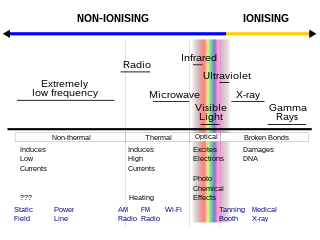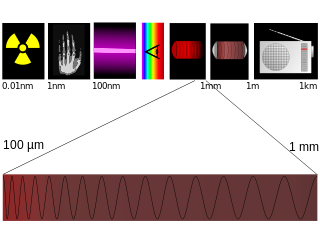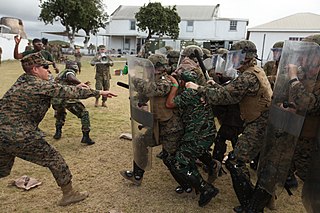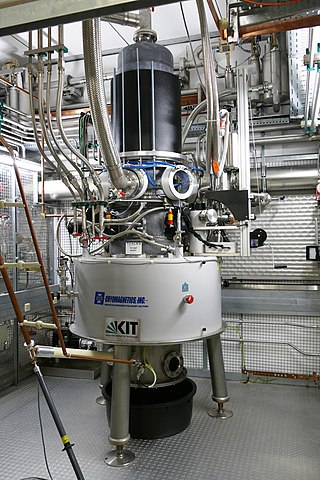History
Development
Two Active Denial Systems were developed under a Defense Department "Advanced Concept Technology Demonstration" Program (now known as Joint Concept Technology Demonstration Program) from 2002 to 2007. Unlike typical weapons development programs in the Defense Department, ACTDs/JCTDs are not focused on optimizing the technology; rather they are focused on rapidly assembling the technology in a configuration suitable for user evaluation. [26]
Contracts
On September 22, 2004, Raytheon was granted an FCC license to demonstrate the technology to "law enforcement, military and security organizations." [27]
On October 4, 2004, the United States Department of Defense published the following contract information:
Communications and Power Industries (CPI), Palto Alto [ sic ], Calif., is being awarded a $6,377,762 costs-reimbursement, cost-plus fixed-price contract. The contractor shall design, build, test, and deliver a two to 2.5 megawatt, high efficiency, continuous wave (CW) 95 gigahertz millimeter wave source system. The contractor shall perform extensive modeling, simulation, experiments, and testing to the maximum capabilities of their facilities (which shall no less than one megawatt peak RF output) that will ascertain the final CW capabilities of the source. The contractor also shall provide input for the requirements for the government's test stand, which will serve as a full power facility in the future. At this time, $900,000 of the funds has been obliged. This work will be complete by January 2009. Negotiations were completed September 2004. The Air Force Research Laboratory, Kirtland Air Force Base, New Mexico, is the contracting activity (FA9451-04-C-0298). [28]
Demonstration
The military has made the ADS available to the media for demonstrations on a number of occasions. A fully operational and mounted version of the system was demonstrated on January 24, 2007, at Moody Air Force Base in Georgia. A Reuters correspondent who volunteered to be shot with the beam during the demonstration described it as "similar to a blast from a very hot oven – too painful to bear without diving for cover." [29] An Associated Press reporter who volunteered to be engaged stated "They certainly convinced me that the system could help save the lives of innocent civilians and our young service members". [30] A CBS News correspondent did an in-depth story on ADS in March 2008. [31] A demonstration was conducted for the media on March 9, 2012, at Marine Corps Base Quantico, Virginia. [32]
Afghanistan deployment

On June 21, 2010, Lt. Col. John Dorrian, a spokesman for the NATO forces commander General Stanley McChrystal, confirmed in an e-mail to Wired reporter Noah Shachtman that the ADS was deployed in Afghanistan. The spokesman added however that the system had not yet been used operationally. [33]
The ADS has been removed from service in Afghanistan as of July 25, 2010.[ citation needed ] A former Principal Deputy Assistant Secretary of Defense noted that the recall of ADS from Afghanistan was an "opportunity missed" and "the non-lethality of the ADS system could prove useful in a counterinsurgency operation where avoidance of civilian casualties is essential to mission success." [34]
Potential deployment against civilians
In September 2020 it was revealed that federal officials had explored the use of the device and the Long Range Acoustic Device to disperse civilians protesting outside the White House in June of that year, but had been advised that the National Guard was not currently in possession of either device. [35] [36]
Problems
There have been speculations in open literature [37] for why the ADS has not been used in a theater of operations. Some of the claimed problems expressed have included: (1) that a potential unreliability in certain environmental conditions, because precipitation (rain/snow/fog/mist) commonly dissipates RF energy, which may moderate the ADS's sensation to "warm and comfortable"; (2) that ADS may only work successfully against exposed skin, implying that heavier clothing may reduce its effectiveness and that its tactical usefulness may potentially be limited in striking specific personnel hiding in crowds of civilians, because this 'hiding' situation has not been seen in all recent theaters of operation (was reportedly observed in Somalia and Iraq, but reportedly not in Afghanistan). What the actual performance of ADS is relative to these concerns is not presently known to be published in open literature.
Future
Following the development of two prototype systems for the ACTD, interest remains in the technology by the military as a means to minimize collateral damage and increase force protection. Research continues on technology that will make it smaller, more reliable, and able to be used on the move, for example, in protection of convoys. [38]











